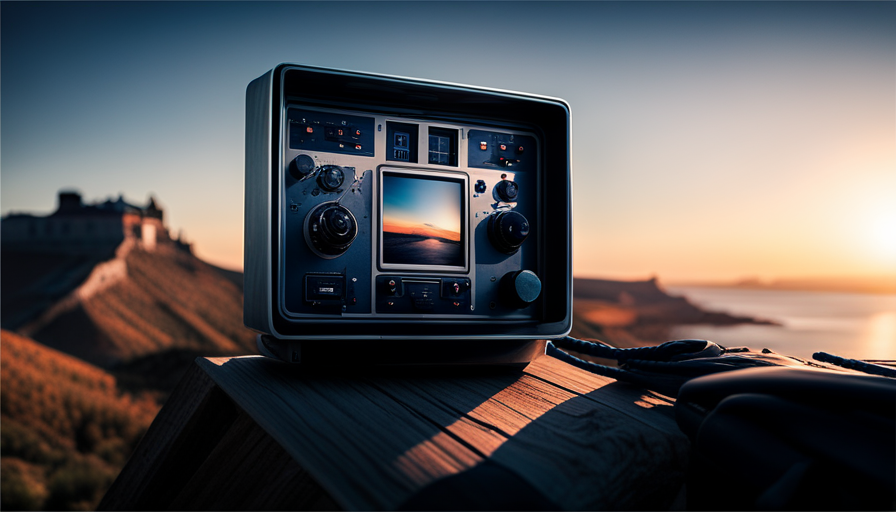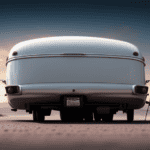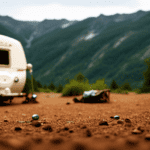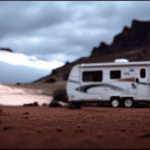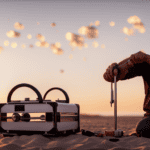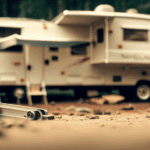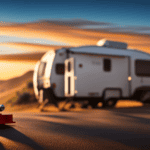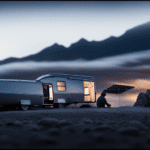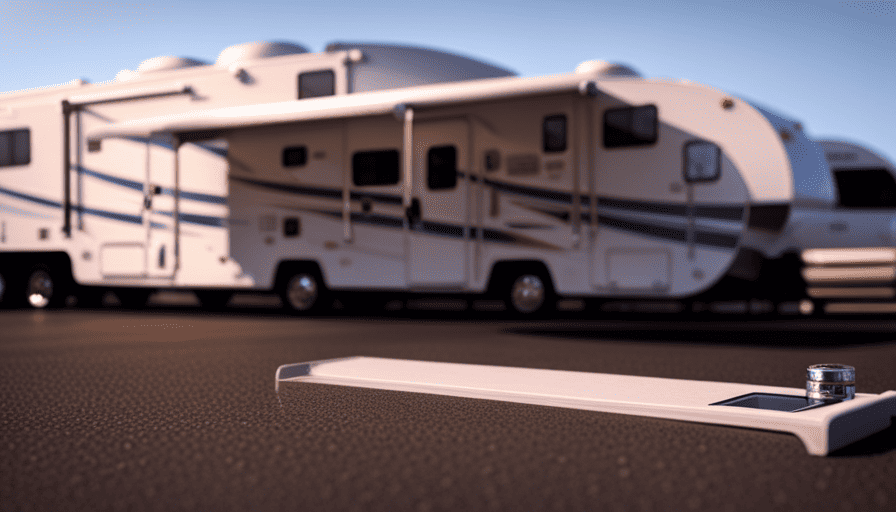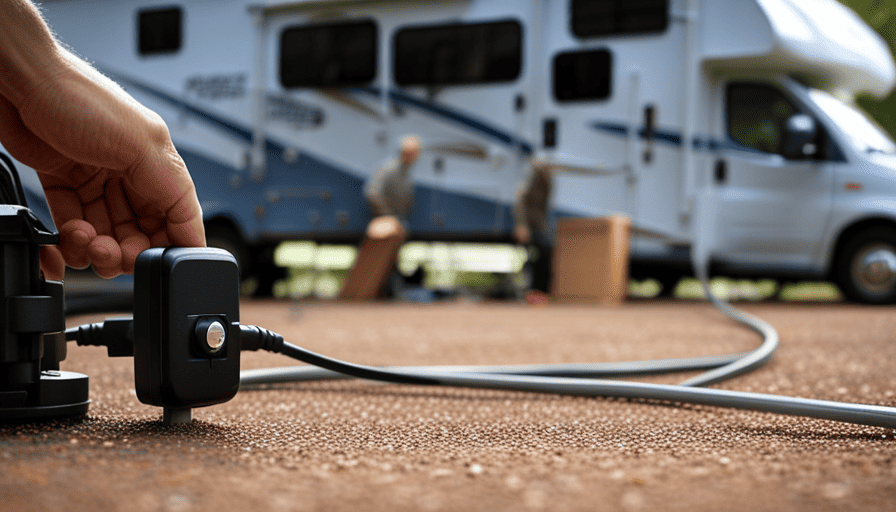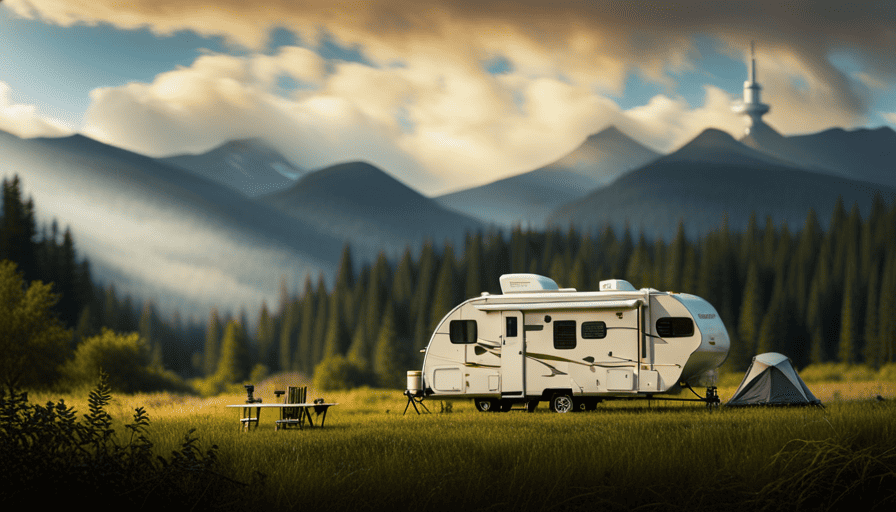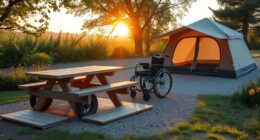Have you ever dealt with the annoyance of a shaky camper? The uneasiness you feel while trying to prepare a meal or rest, always mindful that any slight movement could result in everything tumbling over?
I know that feeling all too well. But fear not, fellow campers, for I have discovered the secrets to permanently stabilizing your camper and restoring your peace of mind. In this article, I will share with you practical tips and techniques to ensure that your camper remains steady and secure, no matter the terrain or weather conditions.
From assessing the current stability of your camper to reinforcing its structure, I will guide you step-by-step through the process of achieving ultimate stability. So let’s dive in and make your camping experience a stable and enjoyable one!
Key Takeaways
- Assess the current stability of the camper and check for signs of instability.
- Invest in stabilizing equipment like leveling blocks, stabilizer jacks, and wheel chocks.
- Properly level the camper using leveling tools and stabilizing jacks or systems.
- Reinforce the structure of the camper, install stabilizer jacks, and distribute weight evenly to improve stability.
Assess the Current Stability of Your Camper
Take a moment to really evaluate how secure your camper feels, ensuring that you’re able to fully enjoy your time on the road without any worries. Assessing the stability of your camper is crucial for a safe and comfortable journey.
Start by checking for any noticeable signs of instability, such as excessive rocking or swaying when parked. Take note of any areas that seem weaker or less stable than others. This could include loose screws, unstable supports, or worn-out stabilizing jacks. Identifying these weak points will help you determine the necessary steps to stabilize your camper.
Next, thoroughly inspect the foundation of your camper. Check for any signs of wear and tear, such as rust or cracks in the frame. Pay close attention to the corners, as they’re often the most vulnerable areas. Additionally, examine the suspension system and ensure it’s in good working condition. If you notice any issues, it’s essential to address them promptly to prevent further damage and instability.
Investing in stabilizing equipment, such as leveling blocks, stabilizer jacks, or wheel chocks, can greatly enhance the stability of your camper. These tools are specifically designed to provide additional support and reduce movement when parked. By addressing any weak points and utilizing the right equipment, you can significantly improve the stability of your camper, ensuring a smooth and worry-free journey.
Invest in Stabilizing Equipment
When it comes to stabilizing my camper, I’ve found that investing in stabilizing equipment is key. Two options that have worked well for me are using stabilizing jacks or leveling blocks. Stabilizing jacks provide additional support and stability to the camper, while leveling blocks help ensure that the camper is level and secure.
Additionally, exploring the benefits of stabilizing systems or hitch stabilizers can greatly improve the stability of the camper and make for a more comfortable camping experience.
Consider Using Stabilizing Jacks or Leveling Blocks
Try using stabilizing jacks or leveling blocks to achieve a permanent stabilization for your camper. These two options are commonly used to stabilize campers and each has its own advantages. Here are three key points to consider when using stabilizing equipment:
-
Stabilizing jacks: These are typically placed under the corners of the camper to provide stability. They’re adjustable and can be extended or retracted as needed. Stabilizing jacks are ideal for uneven surfaces or campsites with slopes.
-
Leveling blocks: These are used to raise or lower specific areas of the camper to achieve a level position. They’re stackable and can be easily adjusted to accommodate the terrain. Leveling blocks are great for campsites with minimal slope.
-
Best practices for using stabilizing equipment: Always make sure to place the jacks or blocks on solid ground for maximum stability. Use a level to ensure the camper is properly leveled. Additionally, it’s recommended to use stabilizing equipment on all four corners of the camper for optimal stabilization.
By using stabilizing jacks or leveling blocks, you can ensure a stable and secure camping experience. Now, let’s explore the benefits of stabilizing systems or hitch stabilizers.
Explore the Benefits of Stabilizing Systems or Hitch Stabilizers
For a smoother ride and increased stability, hitch stabilizers act as the backbone of your camper, providing the necessary support to keep everything in place, like the sturdy roots of a towering oak tree.
Stabilizing systems, such as hitch stabilizers, offer several benefits for your camper. Firstly, they minimize the swaying and rocking motion that can occur during towing, ensuring a safer and more comfortable journey. Additionally, stabilizers help distribute the weight evenly across all tires, reducing the strain on individual tires and improving overall towing safety.
By minimizing the movement of the camper, stabilizers also prevent damage to your belongings inside, keeping everything secure and intact. Properly level your camper to further enhance stability and prevent unnecessary stress on the stabilizers and tires.
Properly Level Your Camper
To ensure your camper remains stable and secure, it’s essential to level it properly. Common leveling mistakes can lead to an unstable camper, causing discomfort and even potential damage.
One mistake is relying solely on your camper’s built-in leveling system, as they can sometimes be inaccurate. It’s important to use a reliable leveling tool, such as a bubble level or leveling blocks, to ensure accuracy. Additionally, using stabilizing jacks or stabilizing systems can greatly improve the stability of your camper.
When it comes to effective leveling techniques, start by parking your camper on a flat surface. This will make the leveling process much easier. Begin by adjusting the side-to-side level of your camper using leveling blocks or by raising one side with a jack. Once the camper is level from side to side, use the front-to-back leveling jacks or stabilizing systems to ensure stability. Take your time and make small adjustments until your camper is perfectly level.
Properly leveling your camper is just the first step in ensuring its stability. Next, you’ll want to secure your camper to the ground to prevent any movement or swaying. This can be done using stabilizing jacks, wheel chocks, or even anchoring systems for added security.
By following these steps, you can enjoy a stable and secure camping experience.
Secure Your Camper to the Ground
Make sure you secure your camper to the ground to prevent any movement or swaying, as studies have shown that unsecured campers are more likely to experience damage during high winds. To achieve ground stability, follow these steps:
-
Find a secure anchor point: Look for a sturdy object like a tree or a large rock that you can attach your camper to. This will provide an additional level of stability.
-
Use heavy-duty straps or chains: Invest in high-quality straps or chains specifically designed for securing campers. These’ll ensure that your camper stays firmly in place, even in strong winds.
-
Attach the straps or chains to the anchor point: Wrap the straps or chains around the anchor point and connect them securely to your camper. Make sure they’re tight and properly fastened.
-
Check for any slack: Once everything’s connected, check for any slack in the straps or chains. Adjust them as necessary to eliminate any excess movement.
-
Reinforce the structure of your camper: Now that you’ve secured your camper to the ground, it’s important to reinforce its structure to further enhance stability.
By securing your camper to the ground with a secure anchor and using heavy-duty straps or chains, you can ensure that your camper remains stable even in adverse weather conditions. This’ll protect your camper from potential damage and provide you with a safer and more enjoyable camping experience.
Reinforce the Structure of Your Camper
Enhance the stability of your camper by reinforcing its structure and enjoy a worry-free camping experience. When it comes to securing your camper, reinforcing its structure is crucial. By strengthening the camper’s foundation, you can prevent it from shifting or tipping over during strong winds or uneven terrain. Here are some effective ways to reinforce the structure of your camper:
-
Install Stabilizer Jacks: Stabilizer jacks provide additional support to your camper by reducing swaying and movement. These jacks are typically placed at the corners of the camper and can be easily adjusted to level the camper and distribute the weight evenly.
-
Upgrade the Frame: Consider upgrading the camper’s frame to a sturdier and more durable one. A stronger frame will provide better stability and reduce the risk of structural damage.
Table:
| Reinforcing Techniques | Benefits |
|---|---|
| Install Stabilizer Jacks | Reduces swaying and movement |
| Upgrade the Frame | Provides better stability |
By reinforcing the structure of your camper, you can minimize movement inside and ensure a safer camping experience. With a solid foundation, you can move on to the next step of minimizing movement inside the camper without compromising its stability.
Minimize Movement Inside the Camper
One way to ensure a more comfortable and enjoyable camping experience is by reducing movement inside the camper. Not only does excessive movement create a noisy and unsettling environment, but it can also result in damage to the camper’s interior.
To minimize noise and prevent damage, there are a few practical steps you can take. Firstly, invest in sturdy storage solutions. Secure your belongings in cabinets or storage compartments with reliable latches. This will prevent them from shifting and causing unnecessary movement while on the road. Additionally, consider using nonslip liners for drawers and shelves to keep items in place.
Next, make use of adjustable stabilizers. These can be attached to the camper’s frame or jacks to provide extra support and stability. By minimizing the camper’s sway, you’ll significantly reduce movement inside.
Another effective way to minimize movement is by using foam padding. Apply adhesive foam strips to areas where objects come into contact with the walls or furniture. This will act as a cushion and absorb any vibrations or impacts, preventing them from transferring throughout the camper.
By taking these simple steps to minimize movement inside your camper, you can create a more peaceful and secure environment.
Now, let’s explore how reducing wind resistance can further enhance your camping experience.
Reduce Wind Resistance
To minimize movement inside the camper, I suggested securing loose items and using stabilizing jacks. Now, let’s talk about reducing wind resistance, which is another important aspect of permanently stabilizing a camper.
Reducing wind resistance is crucial for maintaining stability while traveling. One effective way to achieve this is by making aerodynamic modifications to the camper. This can include adding streamlined shapes to the exterior, such as a curved front or tapered sides. These modifications help to redirect the airflow smoothly around the camper, reducing the impact of crosswinds.
Another option is to install wind deflectors on the roof or sides of the camper. These deflectors are designed to redirect the wind away from the camper, minimizing the force that pushes against it. They can help to reduce the sway caused by strong winds, making your camper more stable on the road.
To summarize, reducing wind resistance is essential for maintaining stability while traveling with a camper. Consider making aerodynamic modifications and installing wind deflectors to minimize the impact of crosswinds.
Now, let’s move on to the next section and discuss how to practice proper weight distribution for further stability.
Practice Proper Weight Distribution
Optimizing weight distribution is key to ensuring a stable and smooth journey while traveling with your camper. Proper weight distribution not only improves the overall stability of the camper but also reduces the risk of sway and improves fuel efficiency. To achieve proper weight distribution, it is important to understand the recommended weight limits for your camper. This information can usually be found in the owner’s manual or by consulting with the manufacturer.
One effective way to distribute weight evenly is by using leveling techniques. These techniques involve adjusting the height of the camper to ensure that it is level from side to side and front to back. This can be done using leveling blocks or jacks. By achieving a level position, you can evenly distribute the weight and prevent excessive strain on the camper’s suspension.
To further optimize weight distribution, it is helpful to use a weight distribution hitch. This device redistributes the weight from the rear axle of the towing vehicle to the axles of both the towing vehicle and the camper. This helps to level the load and improve stability.
Incorporating proper weight distribution and leveling techniques will greatly contribute to a safe and comfortable journey with your camper. However, it is also important to regularly maintain and inspect your camper to ensure its continued stability and safety on the road. Transitioning into the next section about regularly maintaining and inspecting your camper, it is crucial to stay on top of maintenance tasks to prevent any issues that could compromise the stability of your camper.
Regularly Maintain and Inspect Your Camper
Make sure you regularly check and maintain your camper to ensure a smooth and worry-free journey. Keeping up with camper maintenance is essential for stabilizing your camper. To help you stay on top of it, here’s a camper maintenance checklist to follow.
First, inspect the tires regularly and make sure they’re properly inflated. Uneven tire pressure can cause stability issues, so it’s crucial to maintain the correct pressure. Also, check for any signs of wear or damage, and replace tires when necessary.
Next, inspect the suspension system and make sure it’s in good condition. Check for any loose or worn-out parts, and replace them as needed. A well-maintained suspension system plays a vital role in stabilizing your camper.
Furthermore, regularly inspect the stabilizer jacks and make sure they’re functioning properly. These jacks help provide stability when parked, so it’s important to keep them in good working order.
Lastly, check for any signs of water leaks or damage on the roof, windows, and doors. Water damage can weaken the structure of your camper, which may result in stability issues.
By regularly maintaining and inspecting your camper, you can identify and address common stability issues before they become major problems. Remember, seeking professional assistance is always recommended if you encounter any complex or challenging repairs.
Seek Professional Assistance if Needed
If you find yourself in need of assistance with stabilizing your camper, it may be beneficial to consult with experienced RV technicians or mechanics. These professionals have the knowledge and expertise to properly assess and address any stabilization issues you may be facing.
Additionally, if you feel overwhelmed or unsure about stabilizing your camper on your own, it’s worth considering hiring a professional stabilization service. They can provide expert help and ensure that your camper is stable and secure for your travels.
Remember, seek professional assistance if needed.
Consult with Experienced RV Technicians or Mechanics
Consulting with experienced RV technicians or mechanics can provide valuable insights and a roadmap to permanently stabilizing your camper. Here are four reasons why seeking their advice is crucial:
-
Knowledge of common stability issues: RV technicians have encountered various stability problems and understand the underlying causes. They can identify specific challenges unique to your camper and recommend appropriate solutions.
-
Expertise in do-it-yourself stabilizing techniques: These professionals can guide you on effective DIY methods to stabilize your camper. They’ll share tips and tricks, ensuring you have the necessary tools and knowledge to tackle the job confidently.
-
Access to specialized equipment: RV technicians have access to specialized equipment that can aid in stabilizing your camper. They can advise on the best tools to use and potentially provide rentals or recommendations for purchasing.
-
Safety and peace of mind: By consulting with experienced technicians, you can ensure that the stabilizing methods you employ are safe and reliable. Their expertise will give you peace of mind, knowing that you’ve taken the necessary steps to protect your camper.
Considering the valuable insights and guidance they offer, consulting with RV technicians or mechanics is an essential step in achieving a permanently stabilized camper. Consider hiring a professional stabilization service for expert help in further ensuring the stability of your camper.
Consider Hiring a Professional Stabilization Service for Expert Help
Consider entrusting the experts at a professional stabilization service to work their magic on your camper, ensuring it remains rock-solid and ready for your next adventure. These professionals have years of experience in stabilizing campers and can provide you with expert advice on the best methods to keep your camper stable. Additionally, hiring a professional service can be a cost-effective option, as they have the necessary tools and equipment to get the job done efficiently.
To give you an idea of the benefits of hiring a professional stabilization service, here is a comparison table:
| DIY Stabilization | Professional Stabilization |
|---|---|
| Requires research and trial and error | Expert advice and experience |
| May require purchasing specialized equipment | Already equipped with necessary tools |
| Time-consuming process | Efficient and timely service |
| Potential for mistakes and damage | Ensures proper stabilization |
| Limited knowledge and experience | Extensive expertise in camper stabilization |
By opting for professional stabilization services, you can save time, money, and ensure that your camper is stable and ready for your next adventure.
Frequently Asked Questions
Can I use regular tent stakes to secure my camper to the ground?
No, regular tent stakes aren’t enough to secure a camper to the ground. When it comes to weight distribution tips and proper anchoring techniques for campers, it’s important to use specialized camper anchors or heavy-duty stakes designed for this purpose.
These anchors are designed to withstand the weight and force of a camper, ensuring stability and safety. Using the right equipment is crucial in ensuring your camper is securely anchored and stable.
How often should I inspect the stabilizing equipment?
Inspecting the stabilizing equipment of my camper is crucial for its long-term stability. I make it a point to regularly check the equipment for any signs of wear and tear. This includes examining the bolts, nuts, and connections for any looseness or corrosion.
Additionally, lubricating the stabilizing equipment periodically helps to ensure smooth operation. While sandbags can provide some stability, it’s best to use proper stabilizing equipment designed specifically for campers to ensure safety and prevent damage.
What are some common signs of structural damage in a camper?
Some common signs of structural damage in a camper include sagging or uneven floors, cracks in the walls or ceiling, and water damage. These issues can be caused by a variety of factors such as age, improper maintenance, or accidents.
To prevent structural damage, it’s important to regularly inspect your camper for any signs of wear and tear, keep up with maintenance tasks like sealing leaks, and avoid overloading the camper with excessive weight.
Are there any specific weight distribution guidelines for different types of campers?
Weight distribution is crucial for camper stability. It’s like the foundation of a solid structure.
Here are some tips to ensure proper weight distribution: evenly distribute weight from side to side, front to back, and top to bottom. Avoid common mistakes like overloading one side or placing heavy items in the rear.
By following these guidelines, you’ll have a stable and safe camper that won’t tilt or sway while on the road.
How do I properly level a camper on uneven terrain?
To properly level a camper on uneven terrain, there are a few camper leveling hacks and tips that I find helpful:
- First, I use leveling blocks or ramps to raise the low side of the camper until it’s level.
- Then, I deploy stabilizing jacks on all corners of the camper to provide additional support.
- Finally, I check the level again to ensure it’s properly stabilized before settling in.
Conclusion
In conclusion, stabilizing your camper is absolutely essential for a smooth and secure camping experience. By assessing the current stability and investing in stabilizing equipment, you can achieve a level of stability that will make you feel like your camper is rooted to the ground.
Leveling properly and securing to the ground are also important steps in achieving stability. Additionally, reinforcing the structure and reducing wind resistance will further enhance the stability of your camper.
Practicing weight distribution and regularly maintaining and inspecting your camper are crucial for long-term stability. By following these steps, you can enjoy a stable and worry-free camping adventure!


